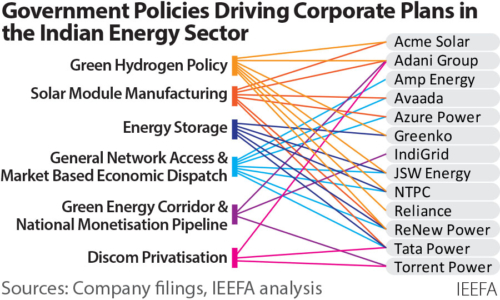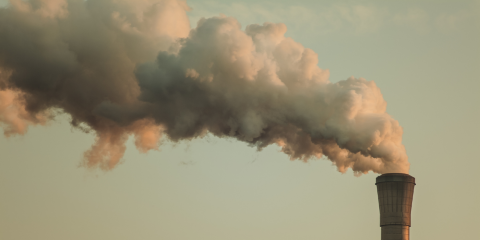India’s lead role in the new wave of energy sector growth

Ambitious government targets and bold business strategies align to meet global climate goals
- The Indian government is rolling out “big bang” clean energy policies and reforms including the green hydrogen and green ammonia policy, production-linked incentive schemes in solar module and battery manufacturing, market based economic dispatch, general network access, green energy corridor schemes and privatisation of state-owned assets across distribution, generation, and transmission.
- Key trends among large power sector companies include diversifying across the value chain, leapfrogging the competition to adopt zero-emissions technologies, and value-added products and services such as peak power supply, round-the-clock supply and corporate decarbonisation solutions.
- Boosting clean energy investments requires clarity and integrity on the policy front and the availability of cost-effective, long-term financing for infrastructure.
3 May, 2022 (IEEFA India): The United Nations climate science body, the Intergovernmental Panel on Climate Change (IPCC), released its Working Group III report with a grave warning for the world. Unless there are immediate and deep emissions reductions across all sectors, 1.5°C is beyond reach. As one of the fastest growing large economies, India has an important role in helping put the world on track to meet climate goals. Its burgeoning energy sector can make a major contribution to immediate and deep emissions reduction, says a new report by the Institute for Energy Economics and Financial Analysis (IEEFA).
“With rampant imported fossil fuel inflation, energy security is a key national priority,” says report author Shantanu Srivastava, energy finance analyst at IEEFA. “India is tackling climate change through ambitious domestic clean energy targets and bold policies and reforms to support them.
“Domestic and international power sector players are rapidly scaling up Indian renewable infrastructure capacities and are preparing for the next wave of sectoral reforms.”
With rampant imported fossil fuel inflation, energy security is a key national priority
The government is rolling out several “big bang” policies and reforms to accelerate the transition to a more resilient and sustainable energy economy while also harnessing investment, employment and import replacement opportunities.
These include the green hydrogen and green ammonia policy, production-linked incentive schemes in solar module and battery manufacturing, market based economic dispatch to democratise the electricity markets, general network access and green energy corridor schemes encouraging investment in the grid sector and private ownership through the National Monetisation Pipeline and the privatisation of distribution companies (discoms).
“The coming decade will be among the most transformational periods for global energy markets,” Srivastava says. “New leaders will emerge, and current corporate giants stand to become obsolete if they do not engage in the transition to the new energy economy.”

Srivastava cites major themes among larger industry players: diversifying across the value chain, leapfrogging the competition in adopting still-evolving new zero emissions technologies, and increasing the range of value-added products and services.
On the green hydrogen front, energy companies are betting on the rapid decline in production costs to exploit its use in energy storage, mobility, fertilisers, refining and industry while also foraying into manufacturing of electrolysers, used to produce green hydrogen from renewable energy. Reliance Industries and Adani Group aim to produce green hydrogen at or below the cost of its fossil fuel counterpart.
In energy storage, industry players are aiming to transform renewable energy from exceptionally low cost but intermittent sources to dispatchable and controllable energy. Companies such as JSW Energy and Greenko are betting big on pumped hydro storage with several development plans.
To diversify upstream in the solar value chain and build domestic supply chain security, players have participated wholeheartedly in the government’s solar module PLI scheme while also acquiring stakes in state discom businesses, integrating the last link of the power sector value chain. Tata Power has achieved impressive results in its Delhi discom over the last decade, expects similar results from its recently acquired Odisha discom, and also has current and pipeline module manufacturing capacities.
In transmission, operators such as IndiGrid InvIT (infrastructure investment trust) and Adani Transmission have been vying for both greenfield and brownfield assets as government agencies look to evacuate the large renewables generation capacity planned for the country.
As the power markets become more democratised and integrated, companies see opportunities in power trading through exchanges and contracting with customers through open access and merchant capacities.
Several industry players have diversified from commoditised electricity generation, distribution and transmission to providing value added products such as peak power supply, round-the-clock supply and corporate decarbonisation solutions, which fetch higher margins and offer growth prospects in a fast-evolving energy economy.
India must build momentum in clean energy investments through policies and corporate actions
“For India to accelerate its transition path,” Srivastava says, “it is imperative to build momentum in clean energy investments through such policies and corporate actions.
“This in turn depends on clarity and integrity on the policy front and the availability of cost-effective, long-term financing to fuel the ambitious long-dated infrastructure plans of industry players. Domestic and global capital providers, for both debt and equity, have provided the latter.”
Srivastava says companies have improved their environmental, social and governance (ESG) disclosure profiles to attract the massive pool of global capital aligned to ESG investing.
“Developing economies such as India,” he says, “have an enormous opportunity to build energy independence and grow in a climate resilient manner, in the process creating a thriving corporate sector that best leverages these increasingly prominent global financial capital market priorities, and funding capacities.”
Read the report: India’s Energy Sector Companies Riding on a New Wave of Growth
Author contact: Shantanu Srivastava ([email protected])
*Author is available for media interviews and background briefings*
Media contact: Roz Hutt ([email protected]) Ph: +61 406 676 318
About IEEFA: The Institute for Energy Economics and Financial Analysis (IEEFA) examines issues related to energy markets, trends and policies. The Institute’s mission is to accelerate the transition to a diverse, sustainable and profitable energy economy. (www.ieefa.org)











